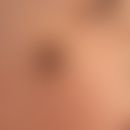DefinitionThis section has been translated automatically.
Exceptionally rare, localized, cyclic inflammatory clinical picture with passive, not infrequently pruritic, inflammatory papules but also transient urticae. The cutaneous disease may be associated with autoimmune diseases (Hashimoto's thyroiditis, lupus erythematosus) (O'Reilly K et al. 2010). In this rare constellation, urticarial lesions have been reported in the setting of the disease, as well as blistering (Schuppli R et al 1981).
PathophysiologyThis section has been translated automatically.
Follicular (primary) mucinosis may present as a benign idiopathic form that is not associated with other cutaneous or extracutaneous diseases. The primary form is usually confined to the face and scalp and is often associated with alopecia (alopecia mucinosa).
In contrast, secondary follicular mucinosis is associated with benign inflammatory diseases such as atopic dermatitis, lupus erythematosus, Graves' disease, or malignancies such as cutaneous T-cell lymphoma (O'Reilly K et al. 2010). In 1997, the association of follicular mucinosis and systemic lupus erythematosus was first reported (Dawn G, et al.1997; Rongioletti F et al. 1986).
You might also be interested in
ManifestationThis section has been translated automatically.
Middle aged men
LocalizationThis section has been translated automatically.
Face (forehead, cheeks, nose, chin) , front neck areas.
TherapyThis section has been translated automatically.
Treatment of secondary follicular mucinosis requires treatment of the underlying disease. Because cases of follicular mucinosis progressing to cutaneous T-cell lymphoma have been reported, patients with persistent or extensive disease should be monitored long-term (O'Reilly K et al (2010).
Note(s)This section has been translated automatically.
The rare follicular mucinosis was first described by Pinkus in 1957. At that time he reported six cases of alopecia mucinosa, a focal alopecia with mucin deposits in hair follicles . In 1959, the disease was renamed follicular mucinosis because of the frequent absence of alopecia.
The entity of "urticarial follicular mucinosis" is controversial. The efflorescent type described is an inflammatory follicular papule. This description is not compatible with the title "urticarial".
LiteratureThis section has been translated automatically.
- Anderson BE et al (2003) Alopecia mucinosa: report of a case and review. J Cutan Med Surg 7:124
- Cinotti E et al (2013) Urticaria-like follicular mucinosis: four new cases of a controversial entity. J Eur Acad Dermatol Venereol 27: e435-7.
- Crovato F et al (1985) Urticaria-like follicular mucinosis. Dermatologica 170:133-135.
- Dawn G, et al.(1997) Follicular mucinosis and systemic lupus erythematosus. Dermatology 195:183
- Harthi FA et al (2003) Urticaria-like follicular mucinosis responding to dapsone. Acta Derm Venereol 83:389-390.
- Jablonska S, et al (1959) Mucinosis follicularis. Dermatologist 10:27
- Marrou K et al (2006) Mucinosis folliculaire ortiée. Ann Dermatol Venereol 133:605-606.
- O'Reilly K et al (2010) Secondary follicular mucinosis associated with systemic lupus erythematosus. Dermatol Online J 16:7.
- Pinkus H (1957) Alopecia mucinosa: inflammatory plaques with alopecia characterized by root-sheath mucinosis. Arch Dermatol 76:419
- Rongioletti F, et al. (2010) Follicular mucinosis: a clinicopathologic, histochemical, immunohistochemical and molecular study comparing the primary benign form and the mycosis fungoides-associated follicular mucinosis. J Cutan Pathol 37:15-19.
- Rongioletti F et al (1986) Papular and nodular mucinosis associated with systemic lupus erythematosus. Br J Dermatol 115:631
- Schuppli R et al (1981) An unusual form of bullous mucinosis of the skin in Hashimoto's thyroiditis. Dermatologica. 162:307-312.
- Tupker RA et al (1997) Urticaria-like follicular mucinosis in a young female patient. Acta Derm Venereol 77:323-324.
Disclaimer
Please ask your physician for a reliable diagnosis. This website is only meant as a reference.





